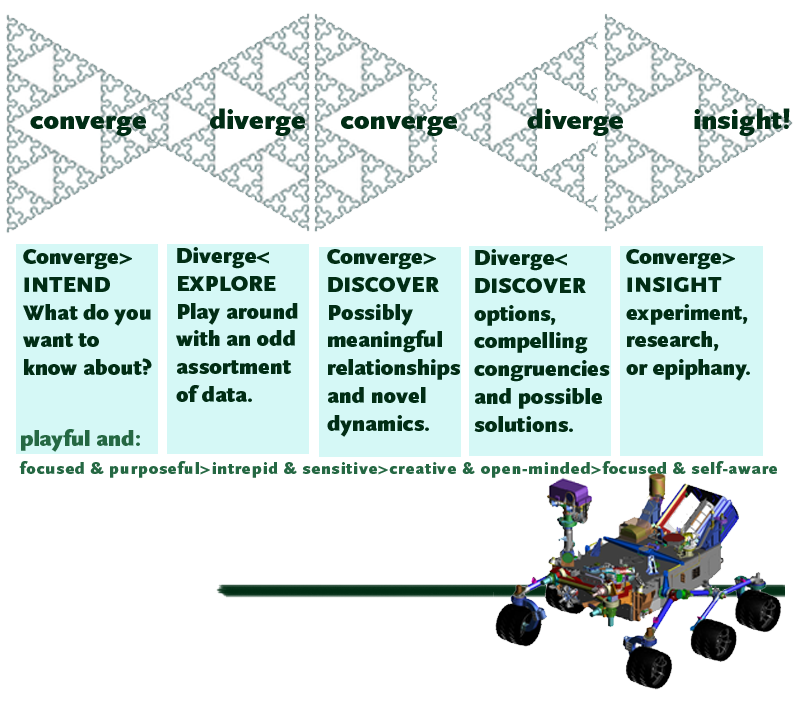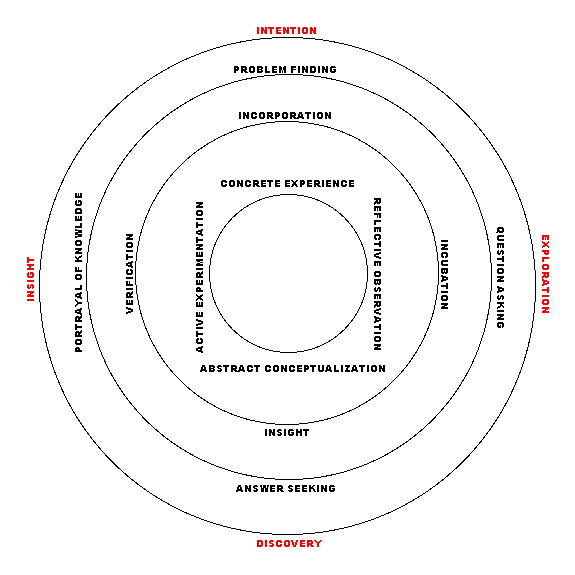Process & Play
DISCOVERY Model of Exploratory Learning
Discovery-based learning unfolds in a playful series of expansion and contraction. It’s hallmark is a reduction of inhibition, willingness to play around with disparate data, and amplification of flexibility and self-awareness.
This is the heart of “transformative learning”
the breaking in of another view,
over which we have no control,
of which we understand little,
but which asks us questions
and puts us in a position of listening.
adapted from Martin Palmer
The fundamental model of experiential learning, developed by David A. Kolb et. al., centers squareONE’s approach to transformative learning. At the same time, squareONE reshapes this model’s practical and applied points of emphasis for the purpose of introducing theoretical turns from the insights of Paolo Freire, Jack Mezirow, and, above all, Gregory Bateson. As well, dynamically viewed, squareONE’s model guides learners through sequences of experiential phases. squareONE’s model is both holistic and is staged in developmental steps. Practically, at the same time, its productive aim is to evoke inner, non-linear, autopoietic dynamics, elicit spontaneous learning, and do this via an intentionally linear, staged and guided process. It, in essence, turns about a brew of strange data, serendipity, novel relationships, and, creative awareness set to the fun task of liberating meaningful new learning from this concoction.
squareONE’s experiential and transformative learning modalities
DISCOVERY LEARNING – squareONE’s bread and butter
Anchored to powerful, personally meaningful intentions, often formulated as questions, Discovery Learning introduces random symbolic and pictoral information to inspire playing around with novel relationships and meaningful synchronies and serendipities. From this process of exploration high value learning is elicited and forged into a result which ranges from an opportunity for further exploration or experimentation to an immediate epiphany.
This kind of learning is easy to characterize. It is all about taking wrong turns, opting for the scenic route, and being open to serendipity and extraordinary new experiences. Set a challenge, explore, search and find, discover. Aha!
HUMAN PUZZLE BASED LEARNING
From the starting point of a meaningful intention or inquiry, The Teaching Story model brings to the process lessons that are used to inform often innovative approaches to reshaping analytic thinking or analytic feeling. At the same time, this process is designed to be playful and humorous. Puzzle-based experiential learning targets habitual analytic approaches for the sake of bringing new tools and approaches to bear on the challenge, or to the inquiry.
DIALOGICAL LEARNING
Learning how to learn and unlearn is the core aim of Dialogical Learning. Its objective is to actively support a person’s ability to explore using dialog or conversation.
The process is precisely focused to collaboratively explore baseline and advanced capacity to: contextualize, make relations, shift viewpoint, self-organize, transform, and to better leverage deeply connected aspirations.
This process is a coaching mode, and it’s also a co-coaching, (or co-counseling,) mode too. Dialogical Learning is a partnership. This process may also be initiated in very small groups–four being the maximum, including the facilitator. Every tool in the squareONE toolkit could be utilized over the course of the process. It also would be likely that learners would invent or otherwise conjure up their own distinctive experiential learning tools.

As a facilitator, I focus my own skills and experience using the lens of attention and presence. I am tenacious about helping learners turn over rocks and bushwhack through new, sometimes strange, territory. My aim is to help learners have lots of fun, and dance their way through a magnetic process to epiphany or the doorway to insight. At its best, playing together is magical and full of a-ha’s.
A lot of what happens from my end is rooted to the audacious promise: set free a daring learner in a creative, embodied process of discovery, collaboratively wander and play around with a serious purpose, and emancipate some nugget worth carrying forward as insight or grounds for further exploration or experimenting.
My facilitation style is enactivist. This means I set my own full embodied consciousness to the task and goal initiated by the learner. It is my experience that deep learning potentials are much more accessible than is widely believed. This underlies my vision as facilitator: exciting learning through play.
(technical) facilitation domains & factors


